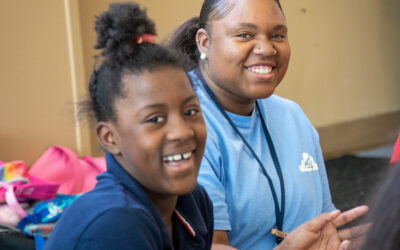Students’ social and emotional development begins at home, making families and caregivers crucial partners in their growth. Research shows that when SEL extends to the home, its benefits multiply. Family members reinforcing and modeling SEL skills can significantly boost a student’s development.
However, many well-meaning parents and caregivers may feel unsure about how to support SEL. As educators and school or program staff, it’s our responsibility to bridge this gap and foster consistency between SEL practiced at home and school.
Here are 15 simple activities that you can share with families to help guide their social emotional learning efforts at home.
Self-Awareness
Words to Live By: “I know my emotions are nothing to hide.”
Resource: Emotional Alphabet
Every day is full of different situations that make us feel a wide range of emotions. Being able to identify and share your emotions helps you understand what you are feeling and why you may be behaving certain ways. The Emotional Alphabet helps build your emotional vocabulary and give you a foundation of words you can use to describe how you are feeling.
Activity #1: Journaling
Have each family member keep a monthly journal of their different feelings throughout the month. The journal can be in the form of their choice (vlog, diary, drawings, reel, slideshow, etc.)
Activity #2: AM/PM Check-Ins
Start and end each day with each family member checking in with another family member to share how they feel. Family members can simply name the emotion or go into further detail if they would like.
Activity #3: Learn and Feel Together
Pick a new word from the Emotional Alphabet each week and set aside time to talk together as a family about what that word means. Discuss how it may manifest in the body and a time you may have felt that emotion.
Self-Management
Words to Live By: “Life’s full of surprises that make me feel different ways.”
Resource: Reset & Relax
Reset and determine what is really bothering you. Relax your mind and body to calm down.
When you feel big emotions it’s important to stop and reset. Try to figure out what is really bothering you. Your emotions are nothing to hide and it’s important for you to feel and identify with that emotion. But it’s also important not to let that emotion take control over you. So after you reset, try to relax your mind and body to calm down. Once you are calm, you can respond to what is really bothering you and not initial feelings.
Coping strategies to help you relax include: listen to music, talk to a friend, exercise, take deep breaths, go for a walk, write in a journal, practice yoga
Activity #1: Daily/Weekly Reflections
As a family, set aside time to reflect on how well you were able to reset and relax. What did you do well? What could you have done differently?
Activity #2: Wind Down Wednesdays
Each week do an activity together as a family to help relax your mind, body, and spirit. Examples: taking a family walk, going swimming, following along to a YouTube yoga/exercise video, etc.
Activity #3: Celebrate Successes
Take time to celebrate family members showing control during big emotions. Celebrate with praise and various incentives.
Responsible Decision-Making
Words to Live By: “I understand the choices I make should be what’s best for me to do, and what happens is on me and not any of you.”
Resource: Avoid a YES Mess
- Could anyone (including myself) get hurt if I do this?
- Could I get into trouble if I get caught doing this?
- Could anything bad happen if I make this choice?
A ‘yes’ answer to any of these questions means the choice leads to a Yes Mess and you shouldn’t make that choice.
All choices have consequences, whether positive or negative. Before making a choice, it’s important to ask yourself these three questions so you can avoid a Yes Mess.
Activity #1: Spot It
As you watch television shows and movies together, spot out situations where you see someone get in a YES Mess by shouting out, “YES Mess.” After the show/movie, have a deeper conversation about what happened in that situation and why it wasn’t a good choice. Make it a competition and see who can spot the most by the end of the month.
Activity #2: Story Time
Each week have family members share a personal story of a time they got into a Yes Mess. Make it a judgment free zone where family members can share without fear of any consequences.
Activity #3: Good Choice Wall
Find a location in the home for family members to post the choices they make that avoid a YES Mess. This could be a dry erase board where family members write their good choices, it could be a poster where family members write on sticky notes, it could be posted on the refrigerator, etc.
Social Awareness
Words to Live By: “I understand others are unique. I want to learn more about everyone I meet.”
Resource: We’re all different and that’s OK
Offer your ideas and listen to other ones.
Keep an open mind and learn from others.
No two people are the same. We are all unique and different and it’s important for us to understand that’s OK. We are not always going to agree with everyone, have the same opinion or perspective, or like the same things. It’s still important that we accept those differences and try to get along with different people. Understanding how to offer your ideas and listen to the ideas of others while keeping an open mind and learning from them helps you learn to value and celebrate the differences of the world.
Activity #1: Family Meetings
Incorporate family meetings in your weekly routine. Set aside a day and time where the family will all meet together and just talk. Encourage family to share any feedback, ideas, suggestions, perspectives, etc.
Activity #2: Suggestion Box
Place a box or jar in a common family area and encourage family members to put any suggestions in the box. Randomly pull out the suggestions and discuss them as a family.
Challenge family members to spend time with someone new each week and learn something new about them. Have them share who and what they learned during a family meal.
Relationship Skills
Words to Live By: “Working together is a must. Kind and caring I will be. I listen to you, you listen to me.”
Resource: Be a TEAM
Tell your strengths and weaknesses
Express words kindly
Act as one-win together, lose together
Make sure everyone is included
Relationship skills are very important. Learning how to work on a team is a large part of building strong relationship skills. A team consists of any 2 or more people working together towards a common goal. This could be a sports team, community group, a family, a class, etc. When each team member recognizes the strengths and weaknesses of one another and plays on those strengths, they are more equipped to make the most of their team.
Taking the time to express words kindly, act as one, and make sure everyone on the team is included, helps everyone fulfill their role on the team and work towards that goal together.
Activity #1: Show and Tell
Pick 1-2 days out of the month for family members to showcase one of their strengths. It could be a Talent Show where each person showcases one of their talents, it could be during family dinner and each member shows a talent and tells more about it, etc.
Activity #2: Friends and Family Day
Set aside a day in the month to have friends and family come together and celebrate one another. Incorporate some friendly competition with team games and activities. Ask everyone in the family for their opinion about what they want to happen at the event and then work together as a family to plan and prepare for the big day.
Activity #3: Kindness Jar
Start a Kindness Jar by getting a Mason Jar and some object you can use to fill that jar (beads, marbles, candy, etc.). Have a family discussion about the importance of expressing words kindly. Let everyone know that the Kindness Jar will be used to showcase how often the family uses kind words. Every time a family member uses kind words, one of the “objects” will be added to the jar. Once the jar is full, the family gets to vote on their reward (go out to eat, trip to the Beach, go shopping, etc.)













